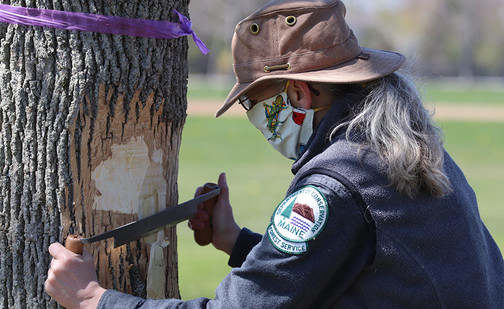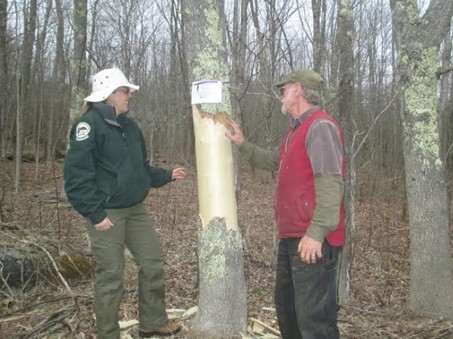DACF Home → Bureaus & Programs → Maine Forest Service → News
Together We Can Do More to Monitor Emerald Ash Borer
February 23, 2021

Colleen Teerling girdling an ash tree (Image -DACF).
"It's too soon for me to start monitoring for emerald ash borer."
"My property is too far away from any emerald ash borer in Maine for us to find it here."
Ive heard statements like this often. But the truth is, there is no area in Maine that is "too far away" from a known emerald ash borer (EAB) infestation to start monitoring for EAB. Girdled trap trees are one of our most powerful monitoring tools to find new EAB infestations as well as to track the inevitable spread of EAB that is already established here.
Every year since we first found EAB in Maine, most of the new detections of EAB farthest away from known infestations have been found due to girdled trap trees. Because this method is so sensitive, we have often found EAB at least a year (and sometimes more) before we start to see more obvious signs of infestation. This gives landowners and towns time to plan harvests and ash management before trees start to show symptoms and it becomes less safe to work in the brittle, declining trees.

A girdled ash trap tree (Image - Blue Hill Heritage Trust)
An additional benefit to both the landowner and the long-term outlook for ash trees in the state is that many of the positive trap trees have become the center of new biocontrol release sites. Maine Forest Service together with USDA APHIS is releasing three types of parasitoids (insect enemies of EAB) for long-term control of EAB, and many of our release sites have been located using girdled trap trees. Releasing these natural enemies early on in an infestation, as is often found by a trap tree, increases their chance of success.
Woodlot owners with ash on their landscape have been at the heart of Maines Girdled Trap Tree Network since its start a decade ago. Any landowner with ash on their property is welcome to be part of this effort. Participants have included municipalities, land trusts, state parks, private landowners and many others.
What we ask is that landowner girdle a tree in the spring. Peeling back the bark all the way around the tree stresses it and draws in any EAB that might be in the immediate area. This cannot draw EAB in from more than a few hundred feet away so you will not attract them to your property if they are not already there. The tree is then felled in the autumn and segments of the tree brought to regional peeling workshops where the bark is carefully removed to look for signs of EAB.
If you think you might be interested in participating in Maines girdled ash tree network, please contact foresthealth@maine.gov or (207) 287-2431. Detailed information on how to choose a good tree and additional instructions will be provided in the spring, at which time you can decide if you wish to participate. If you are interested in participating but are not sure you have the means to set up and remove a trap tree yourself, please sign up, since in some cases MFS can assist with those tasks.
Although EAB cannot be eradicated from Maine, monitoring is a crucial part of slowing the spread of this pest, lowering our costs, and increasing the success of keeping ash on the landscape.

Peeling a girdled trap tree (Image -- Acadia National Park)
- Colleen Teerling, Maine Forest Service Forest Entomologist
Learn more about emerald ash borer and other forest pests
Maine Forest Service staff will provide an overview of some of the invasive insect and pathogens that are currently causing problems for the health of Maines Forests and the emerging threats on Maines doorstep.
Speakers:
Aaron Bergdahl, Forest pathologist
Colleen Teerling, Forest entomologist
Mike Parisio, Forest entomologist
Tom Schmeelk, Forest entomologist
This remote presentation will be held on February 24, 2021 from 2:00 PM - 3:00 PM. The presentation is free and open to the public. If interested please register. CEUs are available.